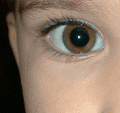 What's that pitcher jumping out of the screen of a laptop computer? It is a snapshot I took at a recent game of the Sacramento River Cats, a Triple-A affiliate of the Oakland A's. I shot it with one of the cameras from a recent 7-megapixel camera roundup. The image measures 3,072 x 2,304 pixels. The picture to the right shows how much of that picture can actually be seen on the 1,024 x 768 pixel display of an average notebook computer. In order to see the whole picture, you'd have to view it at 33 or 25%.
What's that pitcher jumping out of the screen of a laptop computer? It is a snapshot I took at a recent game of the Sacramento River Cats, a Triple-A affiliate of the Oakland A's. I shot it with one of the cameras from a recent 7-megapixel camera roundup. The image measures 3,072 x 2,304 pixels. The picture to the right shows how much of that picture can actually be seen on the 1,024 x 768 pixel display of an average notebook computer. In order to see the whole picture, you'd have to view it at 33 or 25%.
The illustration below shows the same photo as it relates to a picture frame. It is a standard frame, the kind you use to display 8 x 10 inch prints. If you print at 200 dots per inch--plenty enough for a good print--once again you have many more pixels than you actually need. In fact, 7 megapixel is enough to print 11 x 14 inch prints. Some will argue that you should always print at 300 dots per inch, but the quality difference between 200 and 300 dpi is almost always negligible.
The point I am making is that we've now reached a point where we have more than enough pixels in our images for almost any purpose. That's great. I didn't think it would happen this quickly, and I certainly didn't think we'd have 7.2 megapixel in cameras weighing less than five ounces, like the slender little Casio Exilim EX-Z750 that's part of the roundup. Having lots of pixels is good because it allows you to crop unnecessary background and still have enough pixels left over for a good print. The picture frame example below illustrates this. You could zero in on the pitcher and perhaps the ref and cut away the rest, and you would still have enough resolution to print a great 8 x 10 image. If you tried that with a lower resolution camera, you'd end up with a grainy print.
On the other hand, most pictures don't get printed out, or if they do, it's usually the smaller 4 x 6 or 5 x 7 formats. For that, a 3.2, 4, or 5 megapixel camera has plenty enough resolution. If you only look at your prints on a computer, even 2 megapixel will do. And if all you really want is a camera to take pics for eBay, blogs or other web projects, even 1 megapixel images need to be downsized.
The point is that while lots of megapixel is nice and necessary for some projects, it is not essential for everyone. And it certainly isn't a measure for a camera's inherent goodness. Sure, that's what sales clerks will want you to believe, but it isn't so.
In fact, we're now seeing some higher resolution cameras with worse picture quality than their lower resolution predecessors, or lower resolution cameras from the same vendor. How can that be?
It is because megapixel is only one part of the equation. If you squeeze more and more pixels onto a CCD imager of the same size, each pixel sensor (called "photosite") gets smaller and smaller. That makes them less capable of gather light, and since they are so close together they can "leak" into neighboring sensors, which results in blurriness and chromatic aberrations. If the CCD imager stayed the same size, this wouldn't be an issue, but with ever smaller cameras getting ever more megapixels, that's not the case. It's reasonable to expect the emergence of very high resolution imagers that do not have those problems, but right now it's an issue.
The point I am trying to make is this: Do not blindly buy something on megapixel alone. Figure out how much resolution you actually need. And make sure a camera works for you in other areas, like speed, user interface, storage card formats, battery life, and so on.
And if you're in the market for a digital camera but can't justify the cost of new high megapixel camera, buy one with lower resolution. You can now get last year's state-of-the-art cameras for hundreds less! So don't wait and don't get shamed into buying more than you want. Especially when you may not even need it.








